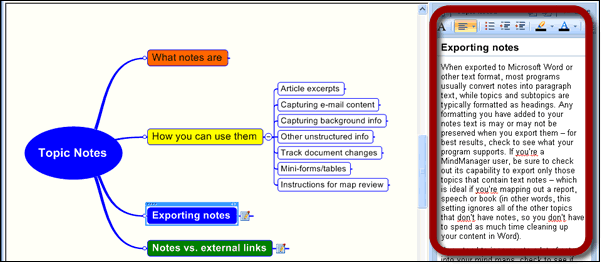#7 in the Effective Mind Maps blog post series
Topic notes represent a great way to store additional information in your mind maps and help to reduce visual clutter and information overload. Here are some tips to help you use them more effectively.
In most software programs, notes may be attached to any topic and are displayed in a separate pane to the right or below the workspace. They are especially useful because they can be easily hidden from view, yet can be accessed via a single mouse click. Many programs enable you to format your text, including, bullet points, numbered lists, tables and more. Once you have added a note to a topic, most programs give you a visual indication – usually by displaying a small note icon next to it.
How can you use topic notes?
This incredible flexibility makes topic notes an ideal repository for:
- Excerpts of articles that you are utilizing for a research project, along with a link back to the source article.
- The text of an e-mail that contains information relevant to a project.
- Capturing background information for a book, article or report you’re writing.
- Phone numbers, addresses and any other unstructured pieces of information that you may need at a future date.
- As a method to manually track changes to topic content, such as a version history. This is especially useful if you’re collaborating with others on a mind map.
- It’s possible to create mini-forms (such as a map revision history table) that can be used within maps to track revisions or other relevant data.
- If you are distributing maps to others to complete, notes are a good place to include instructions.
Topic notes are an essential tool for helping to prevent information overload. Because they are normally hidden from view, they are a great place to store extended information that would otherwise be crowded into your mind map. As a form of visual diagramming, mind mapping was never designed to support more than a word or two per topic. Placing five words, or 20, or 50 any map topic results in a map that is almost unreadable. Notes enable you to create a very concise topic name, and then to capture all of the other important information in a note.
Notes on exporting topic notes to Word
When exported to Microsoft Word or other text format, most programs usually convert notes into paragraph text, while topics and subtopics are typically formatted as headings. Any formatting you have added to your notes text is may or may not be preserved when you export them – for best results, check to see what your program supports. If you’re a MindManager user, be sure to check out its capability to export only those topics that contain text notes – which is ideal if you’re mapping out a report, speech or book (in other words, this setting ignores all of the other topics that don’t have notes, so you don’t have to spend as much time cleaning up your content in Word).
If you tend to incorporate a lot of notes into your mind maps, check to see if the notes pane can be opened and closed using a keyboard shortcut (in MindManager, it’s CTRL + T) – that should significantly increase your productivity.
Capturing information in topic notes vs. linking to external documents
When should you use notes versus linking out to an external document, spreadsheet or other file? If the supporting information that you seek to add to your map is lengthy, longer than two pages, you may want to consider linking out to an external document. The notes windows of most mind mapping programs are highly functional, but you’ll probably find that they become ponderous when used with longer documents.
It also depends upon the nature of the information you are trying to capture. Say, for example, the information you’re trying to capture comes from an article on a news media site. If you don’t capture and save the entire text of that article, you may not be able to find it on their news site two weeks or two months later, because some websites don’t maintain permanent collections of all of their content.
Notes are most useful to you when they are of moderate length; excessively long notes become hard to digest. You may be better off to subdivide a particularly big thoughts into a number of subtopics (the functional equivalent of subheadings in a document) and add shorter notes to each one, rather than create a single enormous note.
(Thanks to Michael Deutch, MindManager evangelist at Mindjet, for contributing some of the topic notes application ideas)
(originally published Jan. 23, 2009. Updated to be included in the Effective Blog Posts series Jan. 9, 2013)


Leave a Reply